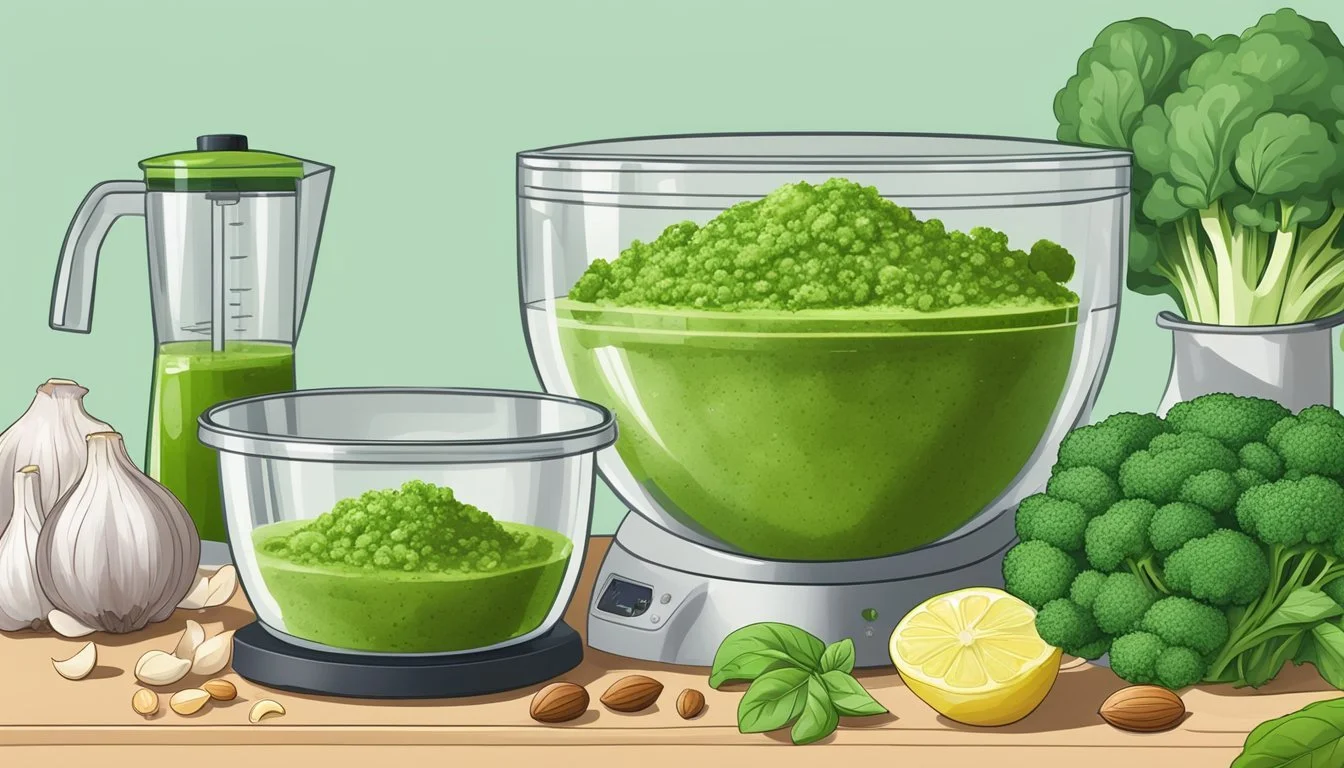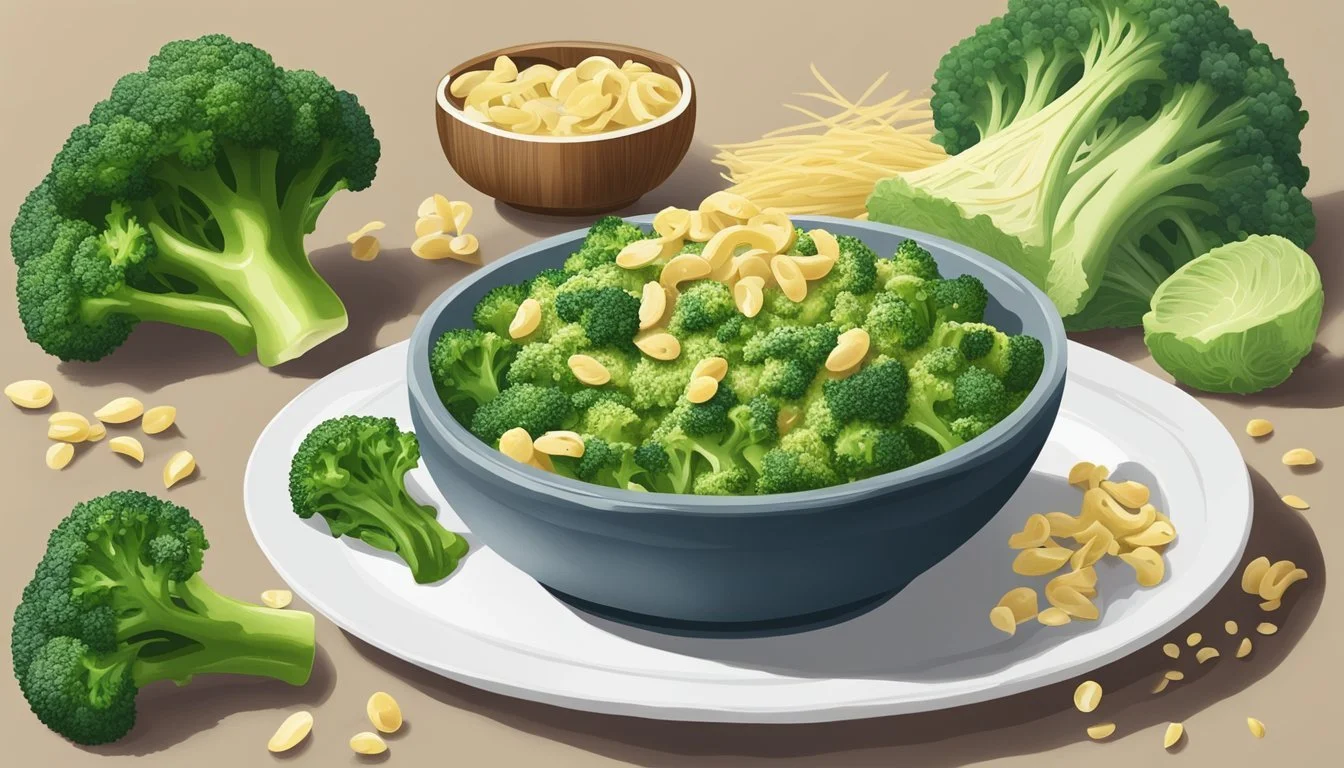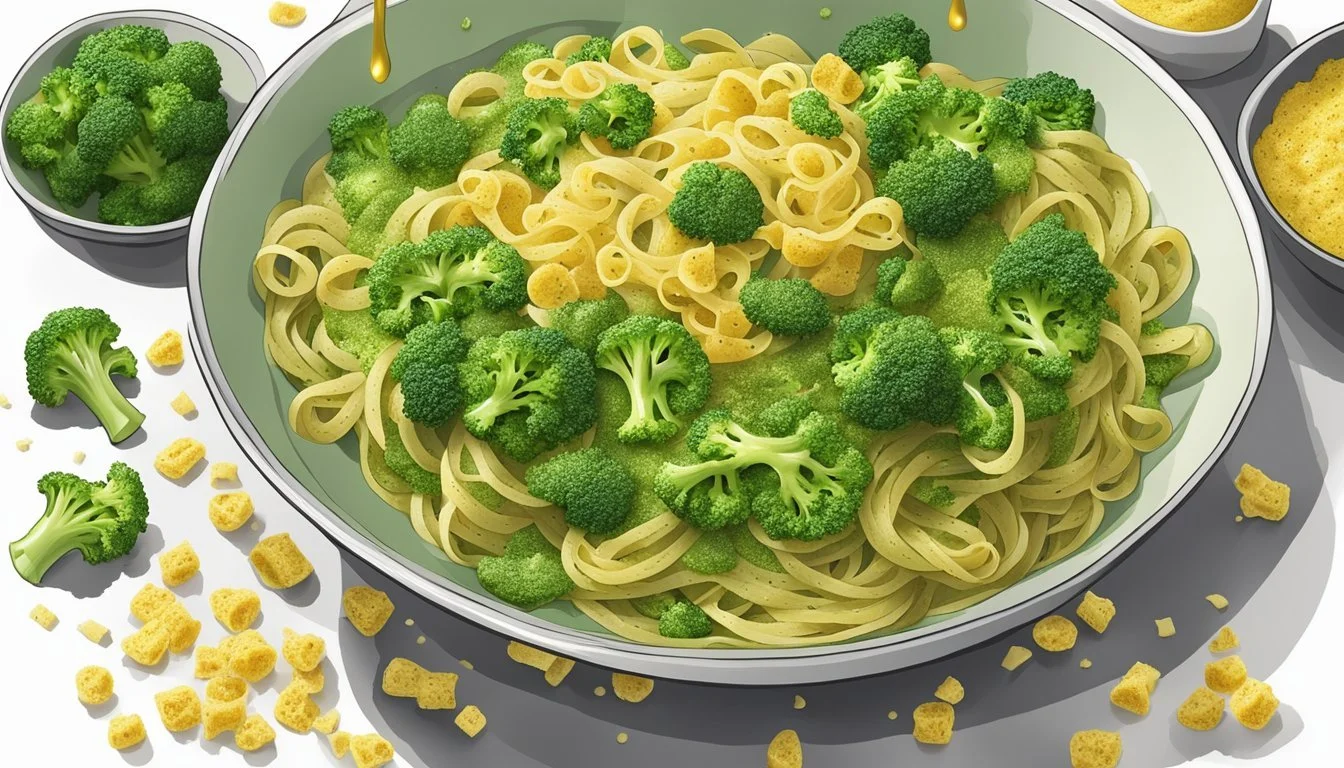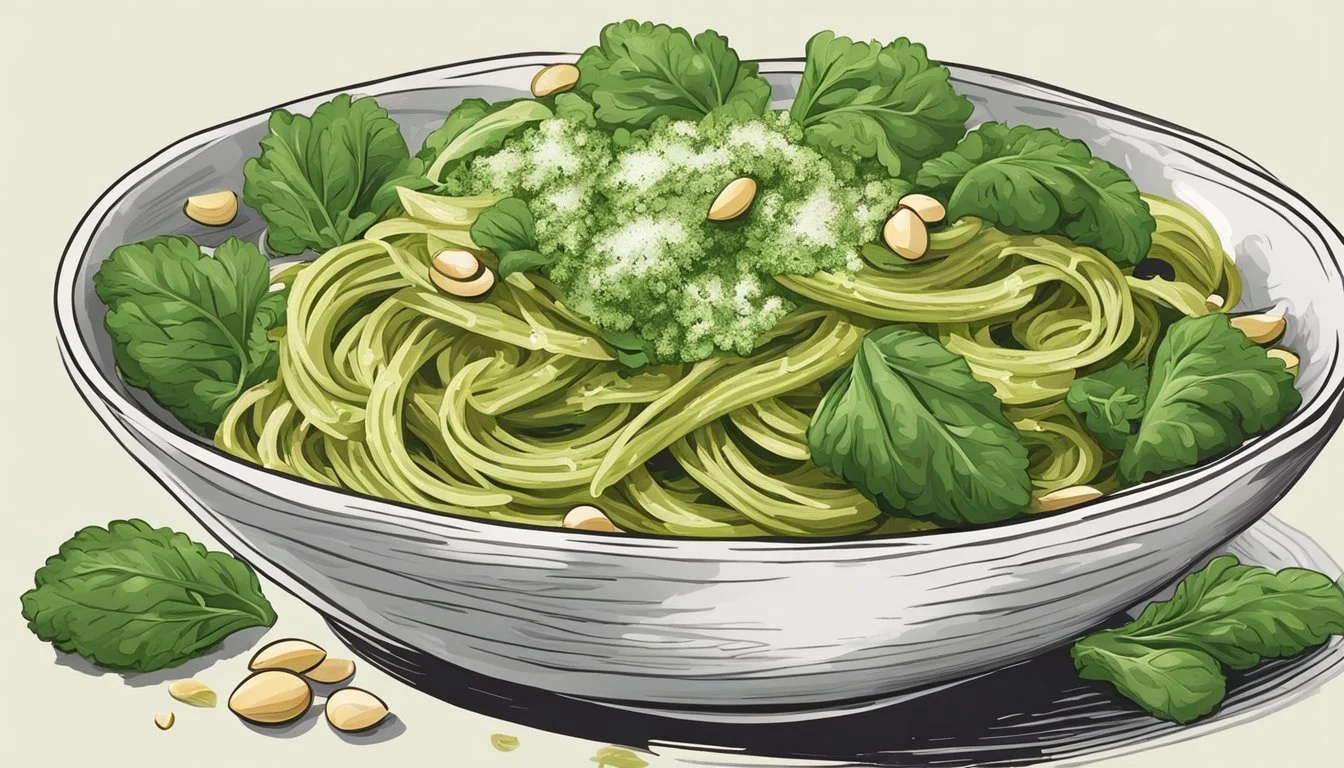Broccoli Stem Pesto
A Culinary Twist on Traditional Flavors
Broccoli stem pesto is a creative twist on traditional pesto, transforming the oft-discarded stems into a flavorful and nutrient-dense pasta sauce. Recognized for its high fiber content and rich supply of vitamins and minerals, the broccoli stem has often played second fiddle to its more commonly consumed floret counterpart. However, resourceful cooks have discovered that these stems, when blended into pesto, yield a creamy and delicious sauce that packs both a nutritional and flavorful punch.
This sauce is easily integrated into a diverse array of dishes, from classic pastas to modern appetizer spreads. Emphasizing sustainability, the use of broccoli stems in pesto aligns with a growing culinary trend of reducing food waste through thoughtful utilization of all edible plant parts. The stems, which contain valuable nutrients such as iron and potassium, are processed along with traditional pesto components like garlic, pine nuts, Parmesan cheese, and olive oil to produce a versatile condiment.
The preparation is simple and similar to that of conventional pesto, but the inclusion of broccoli stems not only enhances the health benefits of the dish but also adds an unexpected depth of flavor. As a result, broccoli stem pesto stands out as a unique and Earth-friendly option for those seeking to enrich their diet with wholesome and delectable choices.
Exploring Broccoli Stem Pesto
Broccoli stem pesto transforms often-discarded broccoli stems into a flavorful, nutrient-dense sauce for pasta dishes, providing a creative and waste-minimizing culinary solution.
What Is Broccoli Stem Pesto?
Broccoli stem pesto is a sauce made from the stems of broccoli, which are frequently overlooked in favor of the more commonly used florets. This pesto incorporates the stems by finely chopping or blending them with traditional pesto ingredients such as garlic, nuts, cheese, and herbs. Not only does this make use of the entire broccoli plant, reducing food waste, but it also offers a twist to the classic pesto with a unique, mild, and slightly sweet flavor profile.
Nutritional Profile of Broccoli Pesto
The nutrition of broccoli pesto stands out due to its inclusion of broccoli stems, which are rich in nutrients. Broccoli, a cruciferous vegetable, is known for its high content of fiber, which promotes digestive health. Additionally, it is an excellent source of vitamin C, an antioxidant that supports immune function. Here's a breakdown of the compounds that contribute to the pesto's health benefits:
Fiber: Essential for digestive health and can contribute to a feeling of fullness.
Vitamin C: Acts as a powerful antioxidant.
Antioxidants: Help reduce oxidative stress in the body.
Potassium: Supports heart health and proper muscular function.
Anti-inflammatory properties: May reduce inflammation in the body.
Sulforaphane: A compound linked with anti-cancer properties.
By incorporating broccoli stems into pesto, the sauce becomes a conduit for these healthful nutrients, contributing to a balanced and nutrient-rich meal when combined with whole grain pasta or used as a condiment for other dishes.
Ingredients Breakdown
Making a nutrient-dense pesto sauce involves carefully choosing ingredients that not only offer health benefits but also complement each other to create a harmonious flavor. The key components in broccoli stem pesto include fresh broccoli, a selection of herbs and spices, quality olive oil, and various other elements that enhance the sauce's taste and texture.
Selecting Quality Broccoli
For the pesto, stems of broccoli are the star ingredient, offering both nutrients and a robust texture. One should select broccoli with a firm stem and vibrant green color, indicating freshness. The stem's bottom end, typically hard and less flavorful, should be trimmed approximately 1 inch from where it was cut from the plant. Using just the tender part of the stem ensures a smoother pesto.
Herbs and Spices to Complement Broccoli
Aromatic herbs and spices elevate the pesto's flavor profile. Fresh basil is essential for its bright and peppery notes, whereas garlic provides a pungent kick that pairs well with broccoli's earthiness. To enhance the mix, a light sprinkle of salt and pepper should be added to taste. For zestiness, lemon juice and a bit of lemon zest contribute a fresh, citrusy accent. Pine nuts impart a mild, nutty undertone to the pesto. One can lightly toast them to bring out their flavor before adding to the food processor.
In crafting this pesto, the cook combines these ingredients with a generous pour of olive oil, which emulsifies the sauce and adds a rich, fruity dimension. The resulting mixture balances the broccoli's robust flavor with the brightness of basil leaves and tangy lemon, rounded out by the warmth of toasted pine nuts and garlic cloves.
Creating the Perfect Texture
Achieving the perfect texture in broccoli stem pesto requires attention to the ingredients that contribute to its richness and the method of blending.
The Role of Olive Oil and Other Fats
Olive oil, particularly extra-virgin olive oil, serves as the foundational fat that lends a smooth and rich consistency to the pesto. The quality of the oil impacts the flavor, with extra-virgin olive oil adding a fruity, peppery note.
Olive Oil: Adds silkiness, helping to emulsify the ingredients.
Nuts: Pine nuts or alternatives like walnuts contribute to the creamy texture while also adding depth.
Blending Techniques for Optimal Creaminess
The equipment used to puree the pesto significantly affects its texture. A food processor or a blender is suitable for making pesto, but each will produce a slightly different consistency.
Food Processor: Offers a coarser, more rustic puree.
Blender: Delivers a smoother and more homogeneous mixture.
Immersion Blender: Handy for a quick puree with easy cleanup, though it may not be as smooth as with a traditional blender.
To ensure creaminess:
Start with pulsing the harder ingredients like nuts to break them down.
Slowly add olive oil to achieve the desired consistency.
Use lower speeds initially, increasing to higher speeds for a smooth finish.
Preparation and Cooking Guide
Preparing broccoli stem pesto is a straightforward process that transforms the often-discarded stems into a delightful and nutritious sauce. This section will guide you through the essential steps and provide insights on optimizing cooking times to elevate the pesto's flavor.
Basic Steps to Making Broccoli Stem Pesto
Prep Time: 10 minutes
Cook Time: 5 minutes
Total Time: 15 minutes
To begin, one must:
Wash the broccoli thoroughly to remove any dirt. Separate the florets and reserve them for another use.
Trim and chop the stems, removing the tough base and any woody outer layers.
Boil or steam the chopped stems to tenderize, which should take about 3-4 minutes for steaming or 5 minutes for boiling.
Drain the stems and immediately blanch in ice water to retain their vibrant color and nutrients.
Pat the stems dry with a paper towel to remove excess moisture.
Combine the broccoli stems in a food processor with ingredients like basil, garlic, nuts (such as pine nuts or almonds), grated Parmesan cheese, lemon juice, salt, and pepper.
Pulse until the mixture begins to blend. Gradually add olive oil while continuing to pulse until the pesto reaches the desired consistency.
Optimizing Cooking Times for Enhanced Flavor
To ensure the pesto is packed with flavor:
Use the steaming method over boiling for the broccoli stems. Steaming helps retain more flavor and nutrients.
Limit the cooking time for the stems to prevent overcooking, which can lead to loss of flavor and nutritional value.
The trick to a flavorful pesto lies in the balance of ingredients and their freshness. A well-monitored steaming process coupled with a quick blending of high-quality components will result in a pesto that is both tasty and healthful.
Heeding these detailed steps, any cook can confidently prepare a delicious broccoli stem pesto, rich in both taste and nourishment.
Serving and Pairing Suggestions
Broccoli stem pesto offers a versatile flavor that complements a variety of dishes. Its rich and nutritious profile enhances meals with a unique twist on traditional pesto.
Best Pastas for Broccoli Stem Pesto
Farfalle: These butterfly-shaped noodles catch pockets of pesto, ensuring a flavorful bite.
Fusilli: The spirals are ideal for holding onto the thicker texture of broccoli stem pesto.
Whole Wheat Spaghetti: A heathy choice that pairs well with the wholesome quality of the pesto sauce.
Alternative Uses Beyond Pasta
Pizza: Substituting tomato sauce with broccoli stem pesto can create a savory and nutritious pizza base.
Salad: A spoonful of pesto can serve as a powerful dressing, bringing a new dimension to fresh greens.
Side Dish: Use the pesto as a garnish on roasted vegetables or as a spread in wraps for an extra burst of flavor.
Adapting the Recipe
When adapting the broccoli stem pesto recipe, individuals can easily accommodate various dietary preferences and nutritional goals. The versatility of the recipe allows for vegan and gluten-free variations, as well as the incorporation of additional proteins to enhance its nutritional value.
Vegan and Gluten-Free Variations
For those following a vegan diet, traditional components like Parmesan cheese can be replaced with nutritional yeast or vegan cheese alternatives to impart a similar savory flavor. Instead of using pine nuts, which are commonly found in pesto, one can opt for seeds such as sunflower or pumpkin to maintain a nut-free option.
To cater to a gluten-free diet, simply ensure that the pasta paired with the broccoli stem pesto is made from gluten-free grains such as rice, corn, or quinoa. Checking the labels for certification can help avoid cross-contamination with gluten-containing products.
Vegan Alternatives:
Cheese: Nutritional yeast, Vegan Parmesan
Nuts: Sunflower seeds, Pumpkin seeds
Gluten-Free Alternative:
Pasta: Gluten-free pasta (check for certification)
Incorporating Additional Proteins
Enhancing the pesto with additional proteins transforms it into a hearty meal. For non-vegans, grilled or baked chicken breast, diced into small pieces, or flaked salmon can be stirred into the pasta for a complete meal. Meanwhile, seafood enthusiasts might appreciate adding cooked fish like tilapia or cod.
For those on plant-based diets, consider incorporating legumes such as chickpeas or lentils to boost protein content without the use of animal products. When integrating proteins, ensure they are cooked and seasoned as desired before adding to the final dish.
Protein Additions:
For meat eaters: Chicken, Salmon, Other fish
For vegans/vegetarians: Chickpeas, Lentils
Health Benefits
Broccoli stem pesto is not just a creative way to use up food scraps; it's a nutrient-packed sauce that has considerable benefits for one's health. This section delves into the specific advantages for heart health and digestive wellness provided by the key compounds found in broccoli stems.
Understanding the Impact on Heart Health
Broccoli stems are rich in fiber and antioxidants, both integral to promoting heart health. Fiber aids in reducing cholesterol levels in the blood, which is a crucial factor in preventing heart disease. Moreover, the antioxidants found in broccoli, including vitamin C and sulforaphane, help in neutralizing harmful free radicals that can lead to arterial damage. A diet high in antioxidant-rich foods like broccoli pesto can contribute to a lower risk of heart conditions.
Digestive and Anti-Inflammatory Benefits
The fiber content in broccoli stems is also beneficial for the digestive system, as it helps maintain regular bowel movements and supports a healthy gut microbiome. Additionally, the compounds in broccoli have anti-inflammatory properties. Sulforaphane, for instance, is being studied for its potential to reduce inflammation and combat inflammatory diseases. Eating broccoli stem pesto may thus support digestive health and mitigate inflammatory responses within the body.
Storing and Freshness
Proper storage is crucial for maintaining the freshness and extending the storability of broccoli stem pesto. An airtight container is essential to ensure the sauce retains its quality.
Keeping Pesto Fresh for Later Use
To keep broccoli stem pesto fresh for later use, one should place the pesto in an airtight container and refrigerate. This pesto can typically be stored in the refrigerator for up to one week. For longer storage, one can freeze the pesto. Use ice cube trays to portion the pesto, then transfer the frozen cubes to a freezer bag or airtight container, which will keep them suitable for consumption for up to six months.
Signs of Spoilage and Proper Disposal
It's crucial to recognize the signs of spoilage in pesto to ensure food safety. Indicators include:
A foul odor, which signifies bacterial growth.
Discoloration; any signs of mold or a change in color from vibrant green to a dull hue.
Taste changes; if the pesto tastes sour or off.
When any signs of spoilage are observed, the pesto should be disposed of immediately to prevent the risk of foodborne illnesses.
Nutritional Information and Diet Integration
Broccoli stem pesto emerges as a nutrient-packed sauce with a diverse profile of vitamins and minerals. It integrates well into numerous diets, providing essential nutrients without excessive calories.
Analyzing Caloric and Macronutrient Content
Broccoli stems are low in calories but rich in various nutrients. A typical serving of broccoli stem pesto might contain the following:
Calories: Moderate
Fat: Low to moderate, with mostly unsaturated fats from olive oil
Saturated Fat: Minimal
Protein: Moderate levels, considering the addition of pine nuts and Parmesan cheese
Cholesterol: Low, present only in cheese
Sugar: Low, natural sugars from broccoli
Sodium: Can be moderate due to added salt and Parmesan cheese
Carbohydrates: Low, primarily from broccoli itself
Table 1: Estimated Macronutrient Content in Broccoli Stem Pesto (per serving)
Nutrient Amount Calories 150-200 kcal Fat 10-15g Saturated Fat <2g Protein 4-6g Cholesterol <10mg Sugar 1-3g Sodium 100-300mg Carbohydrates 6-10g
The amounts can vary based on the specific recipe and portion sizes. Dietitians may highlight the beneficial compounds such as vitamin C, potassium, and sulforaphane, which have been linked to health benefits.
Incorporating Pestos into a Balanced Diet
Integrating broccoli stem pesto into a diet offers a favorable way to add flavor and nutrients without undue amounts of fats, sugars, or sodium. Here are some dietary considerations:
Nutrition: Pesto is a good source of antioxidants and vitamins, making it beneficial for various diet plans.
Fat Content: Utilizes healthy fats from olive oil, which are important for heart health.
Sodium: Careful incorporation is required for those monitoring sodium intake.
Diversity: Pesto can be used on various meals, ranging from pasta to grilled vegetables, (What wine goes well with grilled vegetables?) making it a versatile addition to a balanced diet.
One must be cognizant of portion sizes to maintain the nutritional balance. Whether included in a weight management plan or simply to enhance dietary variety, broccoli stem pesto can serve as a healthful condiment.








